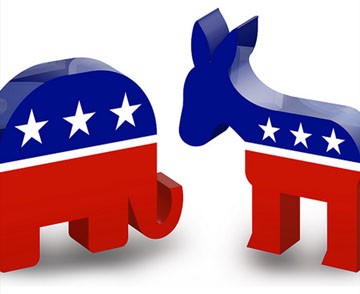Rob Horowitz: An Increasingly Partisan and Polarized People
Tuesday, July 01, 2014

According to Pew, “Republicans and Democrats are more divided along ideological lines--and partisan antipathy is deeper and more extensive—than at any point in the last two decades.” Nearly 3-in-10 Democrats and 4-in-10 Republicans say that the policies of the other party are “so misguided that they threaten the nation’s wellbeing.” Similarly, 3-in-10 consistent conservatives and more than 2-in-10 consistent liberals say they would be unhappy “if an immediate family member married someone who was a member of the other political party.” Over the past twenty years, the percentage of party members having very unfavorable views of the opposing party more than doubled.
This strong dislike of the other party is driven in large measure by a marked increase in the share of the electorate that is comprised of down-the-line liberals or conservatives. The percentage of these ideological adherents doubled over the past twenty years from 10% to 21%. And since ideologically committed voters tend to be the most engaged in politics and government, they exercise a disproportionately large amount of influence on the political process—influence that goes far beyond their numbers. The Pew Report, which accompanied the poll, drives the point home: “On measure after measure-whether primary voting, writing letters to officials, volunteering for or donating to a campaign-the most politically polarized are more actively involved in politics, amplifying the voices that are the least willing to see the parties meet each other half way.”
Sweeping changes in where people choose to live and what media they consume underlie this stepped up ideological and partisan polarization. More Americans now live in ideological silos surrounded mainly be people with like-minded world views.
Plowing ground first unveiled by Bill Bishop in his compelling book The Big Sort-- where Bishop documents how lifestyle choices and mobility worked together to create towns and areas that are much more one party dominant-- Pew demonstrates how conservatives and liberals have very different priorities for what they are looking for in a place to live. For example, 75% of consistent conservatives prefer a community, where, “the houses are larger and farther apart, but schools, stores and restaurants are several miles away.” On the other hand, 77% of consistent liberals, prefer a community where,” the houses are smaller and closer to each other, but schools, stores and restaurants are with-in walking distance.”
Research shows that regularly coming into contact with people of different political views results in a moderating effect. In too many American communities today one mainly encounters people who are like-minded., intensifying ideology. In Bishop’s apt words, “America is hiving.” This is reinforced by the fact that many people now select their news and opinion media according to their ideological and party preference. An overwhelming percentage of FOX viewers, for example, voted for Mitt Romney, while an even higher percentage of MSNBC viewers voted for Barack Obama.
Despite these trends, there are still far more people in the center than on the left or the right. Nearly 4-in-10 Americans ‘take a roughly equal number of liberal and conservative positions. And most people support the kind of compromises essential to breaking through the current gridlock and getting things done.
But for our politics to better reflect majority opinion, centrists must get off the sidelines: not just voting in Presidential elections, but voting in mid-term elections beginning with the critical Congressional elections coming up in November. And centrists must take their place in the public square, speaking up for what they believe.
We’ve seen what happens when politics is left to intense partisans. It is time for the rest of us to take the responsibility as citizens a democracy demands.

Related Articles
- Rob Horowitz: A College Degree Is More Important Than Ever
- Horowitz: Vermont Gives Nation a Wake-Up Call on Opiate Addiction
- Rob Horowitz: Obama Moves into High Gear on Climate Change
- Rob Horowitz: Brewer Veto Cripples Effort to Roll Back Gay Rights
- Rob Horowitz: Rand Paul: One of the Early Republican Frontrunners
- Rob Horowitz: Progress Possible On Immigration Reform
- Rob Horowitz: State of the Union: Obama’s Chance to Set the Agenda
- Rob Horowitz: 5 More Reasons for New Year’s Optimism
- Rob Horowitz: Restore Unemployment Benefits to Long-Term Unemployed
- Rob Horowitz: The War On Poverty, 50 Years Later
- Rob Horowitz: It’s Time to End the Cuban Trade Embargo
- Rob Horowitz: Millennials Coming of Age
- Rob Horowitz: National Attention to Obesity Starting to Pay Off
- Rob Horowitz: Obama Takes Major Step Forward on Climate
- Rob Horowitz: One More Reason to Invest in Infrastructure
- Rob Horowitz: The Moderates: Still Holding the White House Keys
- Rob Horowitz: Obama and Warren: Making Strides on Student Loans
- Rob Horowitz: Former Bush Treasury Secretary Advocates Carbon Tax
- Rob Horowitz: Two Important Developments on the Climate Front
- Rob Horowitz: Social Media: Key Component of the ‘New’ News Media
- Rob Horowitz: Supreme Court Keeps Shredding Campaign Finance Laws
- Rob Horowitz: The Civil Rights Act, 50 Years Later
- Horowitz: Obamacare - Here to Stay and on the Right Track




 Delivered Free Every
Delivered Free Every
Follow us on Pinterest Google + Facebook Twitter See It Read It